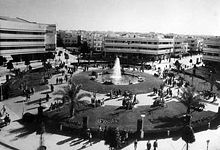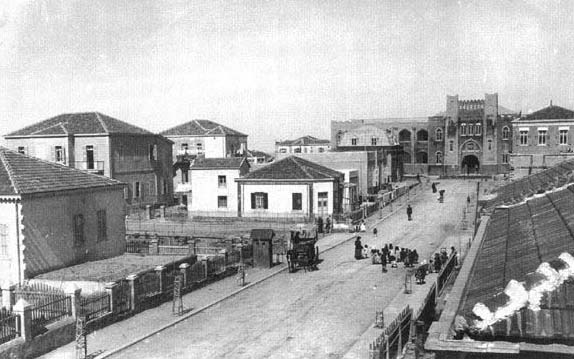Tel Aviv
Tel Aviv - Yafo
Tel Aviv, usually called Tel Aviv, is the second largest city in Israel, with an estimated population of 393,900.The city is situated on the Israeli Mediterranean coastline, with a land area of 51.8 square kilometres (20.0 sq mi). It is the largest and most populous city in the metropolitan area of Gush Dan, home to 3.15 million people as of 2008.The city is governed by the Tel Aviv-Yafo municipality, headed by Ron HuldaiTel Aviv was founded in 1909 on the outskirts of the ancient port city of Jaffa (Hebrew: , Yafo; Arabic: Yaffa). The growth of Tel Aviv soon outpaced Jaffa, which was largely Arab at the time. Tel Aviv and Jaffa were merged into a single municipality in 1950, two years after the establishment of the State of Israel. Tel Aviv's White City, designated a UNESCO World Heritage Site in 2003, comprises the world's largest concentration of Modernist-style buildings.
Mediterranean’s New Capital of Cool
Tel Aviv is classified as a beta+ world city being a major economic hub and the richest city in Israel, home to the Tel Aviv Stock Exchange and many corporate offices and research and development centers. Its beaches, bars, caf?s, restaurants, upscale shopping, great weather and cosmopolitan lifestyle have led to it being a popular tourist destination for domestic and overseas visitors alike, and given way to its reputation as a "Mediterranean metropolis that never sleeps". It is the country's financial capital and a major performing arts and business center. Tel Aviv's urban area is the Middle East's second biggest city economy, and is ranked 42nd among global cities by Foreign Policy's 2008 Global Cities Index. It is also the most expensive city in the region, and 17th most expensive city in the world. New York-based writer and editor David Kaufman called it the "Mediterranean’s New Capital of Cool".
The name Tel Aviv
The name Tel Aviv (literally "Spring Mound") was chosen in 1910 from among many suggestions, including "Herzliya". Tel Aviv is the Hebrew title of Theodor Herzl's book Altneuland ("Old New Land"), translated from German by Nahum Sokolow. Sokolow took the name from Ezekiel 3:15: "Then I came to them of the captivity at Tel Aviv, that lived by the river Chebar, and to where they lived; and I sat there overwhelmed among them seven days. This name was found fitting as it embraced the idea of the renaissance of the ancient Jewish homeland. Aviv is Hebrew for "spring", symbolizing renewal, and tel is an archaeological site that reveals layers of civilization built one over the other. Theories vary about the etymology of Jaffa or Yafo in Hebrew. Some believe that the name derives from yafah or yofi, Hebrew for "beautiful" or "beauty". Another tradition is that Japheth, son of Noah, founded the city and that it was named for him. The name is also transliterated as Tel-Abib in the King James Bible.Urban development
The Second Aliyah
The Second Aliyah led to further expansion. In 1906, a group of Jews, among them residents of Jaffa, followed the initiative of Akiva Arye Weiss and banded together to form the Ahuzat Bayit (lit. "homestead") society. The society's goal was to form a "Hebrew urban centre in a healthy environment, planned according to the rules of aesthetics and modern hygiene. The urban planning for the new city was influenced by the ideas of the Garden city movement. In 1908, the group purchased 5 hectares (12 acres) of dunes northeast of Jaffa. Following this purchase,Meir Dizengoff, who later became Tel Aviv's first mayor, decided to join Ahuzat Bayit. His vision for Tel Aviv involved peaceful co-existence with the Arabs.
In April 1909, sixty-six Jewish families gathered on a desolate sand dune on what is now Rothschild Boulevard to parcel out the land by lottery using seashells. The lottery was organised by Akiva Arye Weiss, the president of the association. Weiss had an original idea, the names of the families were inscribed on white shells and the plot number on shells of a different color. Within a year, Herzl, Ahad Ha'am, Yehuda Halevi, Lilienblum, and Rothschild streets were built; a water system was installed; and 66 houses (including some on six subdivided plots) were completed. At the end of Herzl Street, a plot was allocated for a new building for the Herzliya Hebrew High School, founded in Jaffa in 1906. On May 21, 1910, the name Tel Aviv was adopted. Tel Aviv was planned as an independent Hebrew city with wide streets and boulevards, running water at each house and street lights.
By 1914, Tel Aviv had grown to include more than 100 hectares (247 acres), including several new neighborhoods. However, growth halted in 1917 when the Ottoman authorities expelled the Jews of Jaffa. A report published in The New York Times by United States Consul Garrels in Alexandria, Egypt described the incident where Jaffa deportation of early April 1917. The orders of evacuation were aimed chiefly at the Jewish population.
Tel Aviv continued to grow in 1926 . At the same time, cultural life was given a boost by the establishment of the Ohel Theater and the decision of Habima Theatre to make Tel Aviv its permanent base in 1931. Tel Aviv gained municipal status in 1934.
The population rose dramatically during the Fifth Aliyah when the Nazis came to power in Germany. As the Jews fled Europe, many settled in Tel Aviv, bringing the population in 1937 to 150,000, compared to Jaffa's 69,000 residents. Within two years, it had reached 160,000, which was over a third of the country's total Jewish population. Many new immigrants remained after disembarking in Jaffa, turning the city into a center of urban life. In the wake of the 1936–39 Arab revolt, a local port independent of Jaffa was built in 1938, and Lod Airport (later Ben Gurion Airport) and Sde Dov Airport opened between 1937 and 1938.
Tel Aviv's White City
Tel Aviv's White City, a UNESCO World Heritage Site since 2004, emerged in the 1930s. Many of the German Jewish architects trained at the Bauhaus, the Modernist school of architecture closed by the Nazis in 1933, fled Germany. Some, like architect Arieh Sharon, came to Palestine and adapted the architectural outlook of the Bauhaus as well as other similar schools, to local conditions, creating what is claimed to be the largest concentration of buildings in the International Style in the world.
By the time of Israel's Declaration of Independence on May 14, 1948, the population of Tel Aviv had risen to more than 200,000. Tel Aviv was the temporary government center of the State of Israel until the government moved to Jerusalem in December 1949. However, due to the international dispute over the status of Jerusalem, most foreign embassies remained in or near Tel Aviv. In the early 1980s, 13 embassies in Jerusalem moved to Tel Aviv as part of the UN's measures responding to Israel's 1980 Jerusalem Law.
Today, all but two of the national embassies are in Tel Aviv or the surrounding district.The boundaries of Tel Aviv and Jaffa became a matter of dispute between the Tel Aviv municipality and the Israeli government during 1948. The former wished to incorporate only the northern Jewish suburbs of Jaffa, while the latter wanted a more complete unification. . The government decided on a permanent unification of Tel Aviv and Jaffa on 4 October 1949, but the actual unification was delayed until 24 April 1950 due to concerted opposition from Tel Aviv's mayor Israel Rokach. The name of the unified city was Tel Aviv until 19 August 1950, when it was renamed as Tel Aviv-Yafo in order to preserve the historical name Jaffa.
Tel Aviv thus grew to 42 square kilometers (16.2 sq mi). In 1949, a memorial to the 60 founders of Tel Aviv was constructed. Over the past 60 years, Tel Aviv has developed into a secular, liberal-minded city with a vibrant nightlife and caf? culture.
In the 1960s, some of Tel Aviv's older buildings were demolished and replaced by the country's first high-rises, among them the Shalom Meir Tower, which was Israel's tallest building until 1999. Tel Aviv's population peaked in the early 1960s at 390,000, representing 16 percent of the country's total. A long period of steady decline followed, however, and by the late 1980s the city had an aging population of 317,000.High property prices pushed families out and deterred young people from moving in.


At this time, gentrification began in the poor neighborhoods of South Tel Aviv, and the old port in the north was renewed. New laws were introduced to protect Modernist buildings, and efforts to preserve them were aided by UNESCO recognition of the Tel Aviv's White City as a world heritage site. In the early 1990s, the decline in population was reversed, partially due to the large wave of immigrants from the former Soviet Union. Tel Aviv also began to emerge as a high-tech center. The construction of many skyscrapers and high-tech office buildings followed. In 1993, Tel Aviv was categorized as a world city. The city is regarded as a strong candidate for global city status.
History of Tel Aviv
In 2009, Tel Aviv celebrated its official centennial. In addition to city- and country-wide celebrations, this anniversary saw the public release of several significant digital collections of historical materials. These include the History section of the official Tel Aviv-Yafo Centennial Year website; the Ahuzat Bayit collection, which focuses on the founding families of Tel Aviv, and includes photographs and biographies, and Stanford University's Eliasaf Robinson Tel Aviv Collection, documenting the history of the city. The last of these consists of several thousand photographs, postcards, posters, books, and other historical documents from the 100-year history of Tel Aviv.




